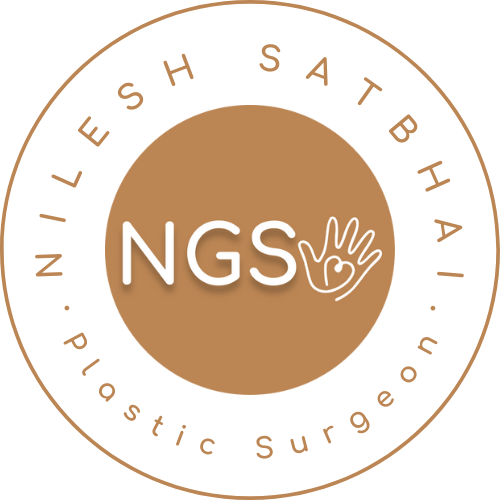Typing Fingers Pain? Carpel Tunnel Syndrome Fixes - Guide
Ever felt that annoying tingling or achy numbness creep up your fingers after a long day of typing? Hand pain affects millions, impacting daily activities and overall well-being. While Carpal Tunnel Syndrome (CTS) often takes the blame, the culprit behind your hand woes might be a different story. In this blog, Dr. Nilesh Satbhai untangles the truth about typing pain and CTS, explores ways to prevent it, and empowers you to keep your fingers flying pain-free.
Understanding Carpal Tunnel Syndrome
Imagine a narrow passageway in your wrist called the carpal tunnel. Inside, the median nerve, responsible for sensation and movement in your thumb, index, and middle fingers, snuggles alongside tendons. Repetitive hand movements can cause inflammation in the tunnel, squeezing the nerve and leading to the telltale symptoms of Carpel Tunnel Syndrome (CTS). The symptoms of CTS are:
-
Numbness or tingling: Especially in the thumb, index, and middle fingers, often worse at night.
-
Pain: Radiating from the wrist into the fingers, sometimes described as a burning or aching sensation.
-
Weakness: Difficulty gripping objects or performing fine motor tasks.
But is it just CTS?
While CTS is a common culprit, other conditions can mimic its symptoms. Repetitive strain injury (RSI) affects muscles and tendons, while tendinitis inflames the tendons around the wrist. A sprained wrist or writer’s cramp can also cause similar pain.
Here’s how we can differentiate CTS from other conditions with similar symptoms:
Repetitive Strain Injury (RSI)
-
Symptoms: Can overlap with CTS, including pain, tingling, and weakness. However, RSI often affects a broader area, like the whole hand or forearm, instead of focusing on specific fingers. Additionally, weakness might be more prominent with RSI.
-
Cause: Repetitive use of muscles and tendons, not necessarily compression of a nerve.
-
Treatment: Similar to CTS, including rest, ergonomic adjustments, stretching, and pain management. Sometimes, physical therapy or other targeted muscle treatments may be helpful.
Tendinitis:
-
Symptoms: Pain and tenderness focused around the specific tendon that’s inflamed. In wrist tendinitis, pain might be on the back or front of the wrist, depending on the affected tendon. Unlike CTS, numbness and tingling are less common.
-
Cause: Inflammation of a specific tendon due to overuse or repetitive strain.
-
Treatment: Rest, ice, pain management, and specific stretches or exercises to strengthen the tendon and surrounding muscles.
Sprained Wrist:
-
Symptoms: Sudden onset of pain, swelling, and bruising around the wrist joint. Unlike CTS, numbness and tingling are rare. Range of motion in the wrist is typically limited due to pain and inflammation.
-
Cause: Injury to the ligaments that support the wrist joint, often from a fall or forceful impact.
-
Treatment: Rest, splinting, ice, and pain management. Physical therapy may be needed later to regain full range of motion and strength.
Writer’s Cramp:
-
Symptoms: Muscle spasms and involuntary contractions in the hand and fingers, making it difficult to write or perform fine motor tasks. Numbness and tingling are usually not present.
-
Cause: Repetitive hand and finger movements associated with writing or other fine motor activities.
-
Treatment: Avoid triggering activities, relaxation techniques, Botox injections, and in severe cases, surgery.
Risk Factors: Beyond the Keyboard
While typing can contribute, it’s not the sole culprit. Certain factors up the ante for CTS:
-
Occupations: Jobs with repetitive hand movements, like assembly lines or playing musical instruments, increase the risk.
-
Health conditions: Diabetes, obesity, and hormonal changes like those during pregnancy can put you at greater risk.
-
Genetics: Family history of CTS can play a role.
Can a Change in Ergonomics Help to Get Relief from Carpel Tunnel Syndrome (CTS)?
As the pandemic and associated lockdowns cause more people to work from home, it is now essential that creating an ergonomic office workspace should be a priority. Failing to set up your desk in a comfortable and accessible way can lead to an increase in repetitive stress injuries like carpal tunnel syndrome (CTS).
CTS is caused by spending long periods typing or using the computer mouse. To avoid this, you should invest in an adjustable desk and chair that can fit your height. This will ensure you don’t slouch while working and can keep your eyes correctly aligned with your monitor or laptop while typing.
Furthermore, make sure your arms form a 90-degree angle when placed on your trackpad or keyboard for comfort while inputting data or typing emails. If you can, also add an ergonomically sound wrist rest so that you’re not directly putting all your weight on the nerve complex in your fingers, wrists and hands as you type away at documents. Taking small breaks every hour will also help reduce the risk of CTS developing from long-period static posturing at your desk.
Before resorting to drastic measures, let’s optimize your workspace:
-
Keyboard height: Elbows at a 90-degree angle, wrists straight.
-
Neutral hand position: Avoid bending your wrists upwards or downwards.
-
Wrist support: Use a cushioned pad to keep your wrists level.
-
Take breaks: Stretch and move your hands every 20-30 minutes.
-
Strengthening exercises: Build hand and forearm strength with simple exercises.
How to Address the Signs of Creeping CTS Pain Right Away?
Carpal tunnel syndrome can be a troublesome and painful condition, but the good news is that it can be avoided or minimized if symptoms are addressed in the early stages. When you start to feel discomfort in your hands and wrists at the end of a long day, it may be the onset of carpal tunnel syndrome. Instead of ignoring these warning signs, you should take action. Incorporating stretch breaks into your daily routine can help reduce strain on your hands and wrists and may even prevent any further development of carpal tunnel syndrome.
Every hour or so, dedicate three minutes to massaging your hands, wrists and forearms while moving them gently in all directions like circles and stretches. Additionally, implement methods such as applying heat therapy to your hands using therapeutic hot pads or blankets to help relax tense muscles in the area. Taking these precautions will provide you with some relief from the initial symptoms of carpal tunnel syndrome, allowing you some respite before seeking out medical assistance if the pain persists or worsens.
When to Seek Professional Help for Carpel Tunnel Syndrome (CTS)?
If the pain persists, consulting a healthcare professional is crucial. Dr. Nilesh Satbhai, a skilled plastic surgeon, can provide expert diagnosis and treatment for CTS and other hand conditions. Early intervention is key to preventing long-term complications.
7 Everyday Habits That Can Hurt Your Hands
Understand the potential risks associated with everyday activities
Are There Any Non-surgical Treatments for Carpel Tunnel Syndrome (CTS)?
Fortunately, CTS often responds well to non-surgical treatments:
-
Wrist splints: Immobilizing the wrist can reduce inflammation and ease symptoms.
-
Physical therapy: Targeted exercises can strengthen hand muscles and improve flexibility.
-
Lifestyle adjustments: Maintaining a healthy weight, managing underlying health conditions, and avoiding activities that exacerbate pain can go a long way.
When is Surgery Necessary for Treating Carpel Tunnel Syndrome (CTS)?
In severe cases where conservative measures fail, surgery like carpal tunnel release can be an option. This minimally invasive procedure relieves pressure on the median nerve, offering lasting relief.
How to Prevent Carpel Tunnel Syndrome (CTS)?
Hand health is an integral part of overall well-being. Here are some lifestyle tips to keep your fingers happy:
-
Maintain a healthy weight: Excess weight puts extra strain on your hands.
-
Stay active: Regular exercise improves circulation and strengthens muscles.
-
Manage stress: Stress can exacerbate hand pain. Practice relaxation techniques like yoga or meditation.
-
Listen to your body: Don’t ignore pain! Take breaks, adjust your posture, and seek help if needed.
Carpal Tunnel Syndrome (CTS) Stretching
Pressure on the median nerve can be relieved by doing certain stretching exercises. Wearing a splint may also help. However, please note that if you experience any pain while performing a stretch exercise then stop doing it and consult an expert.
Prayer Stretch
Prayer stretch, also known as Anjali Mudra, is an easy and simple stretch to do at your desk that involves pressing your palms together, usually in front of your chest below the chin. This helps to relieve tension in the arms and shoulders while calming the mind.
The aim is to lengthen and relax the muscles along your arms from shoulder to fingertips. To get started with this stretch, start with your palms pressed together and near your stomach. Slowly lower them towards your waistline until you feel stretching under your forearms. You can hold this position for 15-30 seconds before releasing it and repeating it two to four times depending on how you are feeling.
Prayer stretches encourages good posture which will help ease back pain and other posture-related health issues with just a few poses at home or work.
Wrist Stretch
The wrist extension stretch is a great way to increase mobility and flexibility in the forearm and wrists. The American Academy of Orthopaedic Surgeons recommends a simple stretching exercise to improve range of motion and strength in the forearm. To do this, extend your arms out straight in front of you with your palms facing up.
Bend your wrist back into a “stop” position while gentle pressure should be applied using your opposite hand across the palm. It’s important not to overstretch as that can cause injury or soreness so be sure to only gently pull back until you feel some mild stretching in the forearm. Hold this position for 15 seconds and repeat five times on each side before switching arms for best results.
Consistent stretches throughout the week can make a significant difference in preventing soreness after intense workouts involving weightlifting, bodyweight exercises, or any outdoor adventure activities like climbing, biking, or running.
Wrist Flexion Stretching Exercises
The wrist flexion stretch is an effective way to relieve tension and stress in the forearm area. By pushing your fingertips toward your body with the opposite hand, you can feel the outside of your forearm being stretched. This type of stretching is great for relieving pain and tightness in your wrists due to repetitive use or overuse.
When performing the wrist flexion stretch, be sure to hold the position for 15 seconds and repeat it five times on each arm. Make sure that you keep breathing while stretching and that you go slowly so as not to overextend or cause injury.
The goal is to relax the muscles in your arms and to improve the overall range of motion at your wrists. The point of this particular stretch is also great for improving coordination between your hands and visual accuracy since you’ll be working against gravity with one arm reaching out while the other stays still, this will help you build stability control at wrist level as well!
Fist Exercises
This simple exercise is an excellent way to promote strength and flexibility in the hands. It can be done either sitting or standing and involves straightening out your fingers before curling them inwards to form a “hook” fist. The fist should be held for a few seconds before returning your hand to its original position. This process should then be repeated with a full fist, providing resistance training for the muscles of the hand and wrist.
Hand Shakes
Shaking your hands can be an easy and efficient way to relieve tension in your muscles. When you’re at work, chances are you spent hours sitting down hunched over your desk, typing away on the keyboard or working on other tasks. After a while, muscle tension can start to become apparent, making your hands and arms feel stiff and achy. To quickly ease this tension, try a simple handshake that requires almost no effort.
To do it, simply stretch out both of your hands in front of you like you just finished washing them and are now trying to air dry them. Shake out each hand at the wrist independently with small motions for several seconds before swapping to the other side. Doing this helps release tension in your fingertips up through your shoulders, allowing more comfortable movement in those areas after just a few moments. Spend 30 to 60 seconds shaking each hand if needed for optimal relief and you’ll find yourself feeling less soreness upon completion!
Typing pain doesn’t have to be your reality. By understanding the causes and risks of CTS, practicing good ergonomics, and seeking professional guidance when needed, you can keep your fingers dancing pain-free on the keyboard and beyond. Try out the exercises mentioned in the blog and feel the difference in your pain. Dr. Nilesh Satbhai is always here to help you reclaim hand health and get back to doing what you love.






